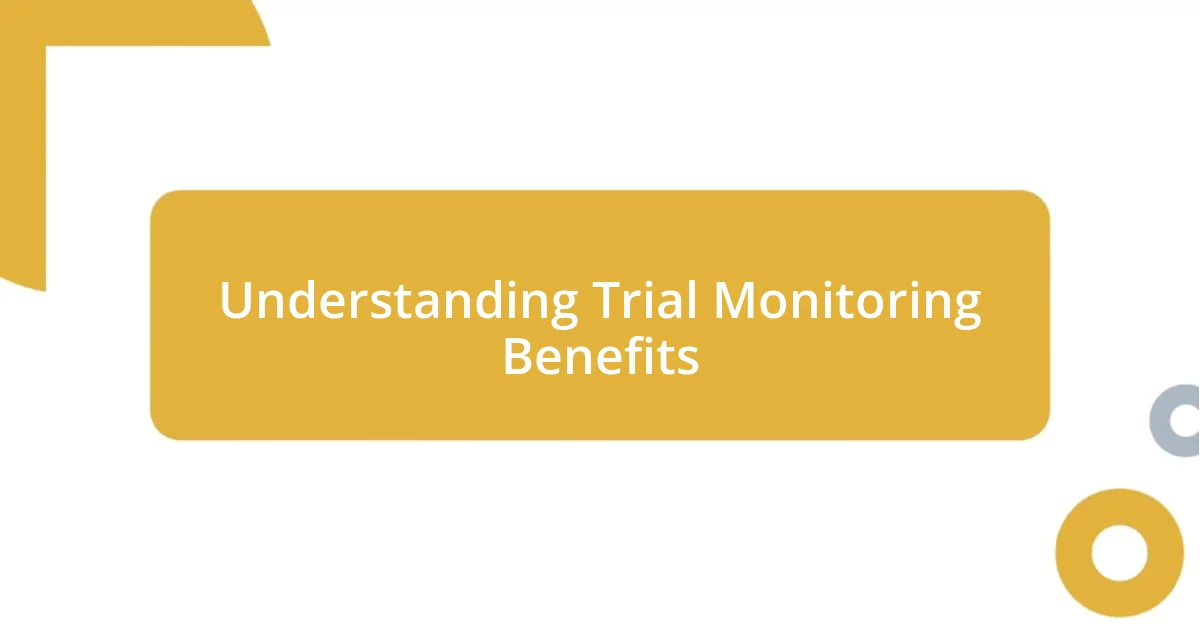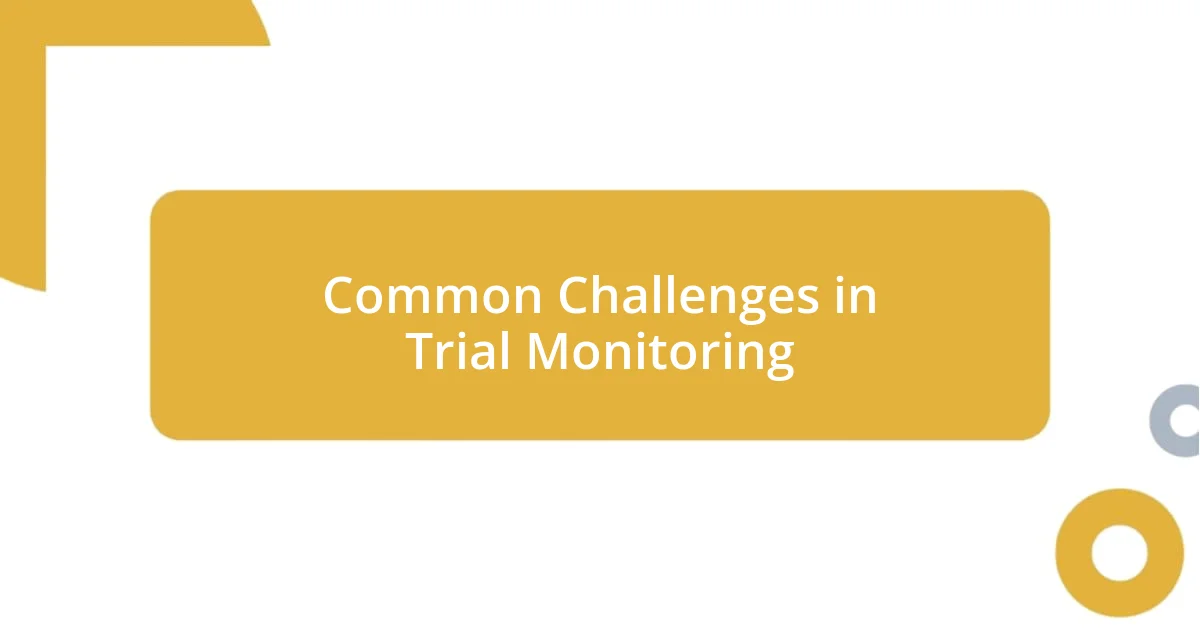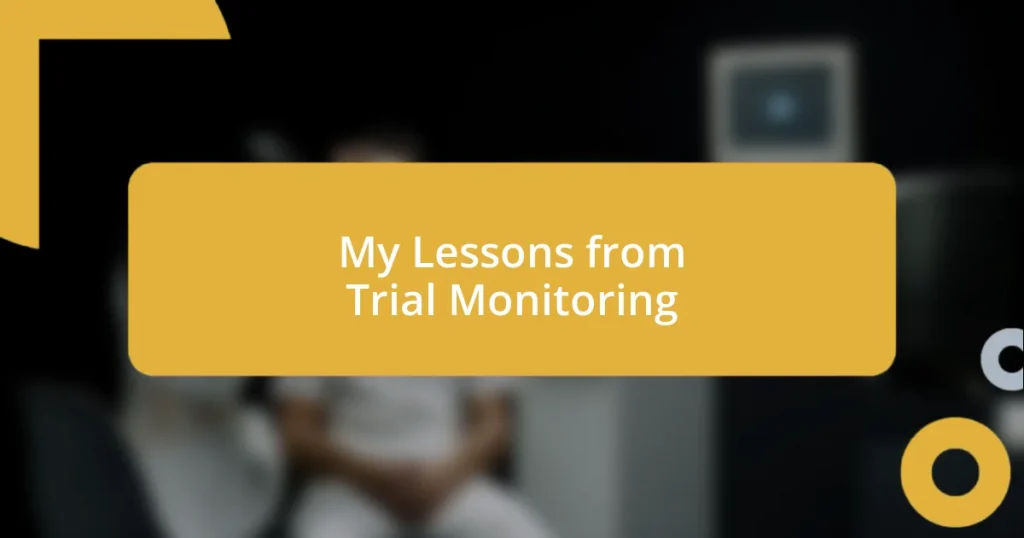Key takeaways:
- Effective trial monitoring enhances patient safety and study integrity through real-time data tracking and open communication.
- Key skills for monitors include attention to detail, analytical thinking, and empathy, which foster strong relationships with participants and ensure accurate data collection.
- Success in clinical trials should be defined by both quantitative metrics and qualitative feedback, emphasizing participant wellbeing and adaptability in monitoring practices.

Understanding Trial Monitoring Benefits
One of the main benefits of trial monitoring is the assurance it provides, both for researchers and participants. I remember the first time I oversaw a clinical trial; the sense of responsibility was overwhelming. Could you imagine knowing that people’s health outcomes hinge on the data you meticulously track? Real-time monitoring can help catch inconsistencies or issues early, ultimately ensuring patient safety and study integrity.
Additionally, maintaining open lines of communication throughout the trial is crucial. I often found myself on calls with the study team, discussing data points and participant feedback. This collaborative approach not only enhanced our understanding of the trial’s progress but also fostered trust among the team and the participants. When everyone feels included and informed, doesn’t that create a stronger commitment to the study’s success?
Moreover, effective trial monitoring can lead to improved outcomes and faster timelines. It’s fascinating how a little proactive adjustment—like addressing a protocol deviation or participant concern—can have such tremendous ripple effects. Reflecting on my experiences, I can attest that feeling empowered to make those quick adjustments transforms a potentially chaotic situation into one of clarity and success, benefiting all involved.

Key Skills for Effective Monitoring
Effective monitoring in clinical trials hinges on a set of core skills that I’ve found to be absolutely critical. One memorable moment for me was when I discovered a discrepancy in patient data that could have led to significant risks if left unaddressed. This experience underscored the importance of keen attention to detail, which I believe is non-negotiable in this field. The ability to analyze data critically and spot anomalies is not just a skill but an essential mindset that can safeguard participant safety and study integrity.
Here are some key skills that are vital for effective monitoring:
- Attention to Detail: Being able to scrutinize data effectively prevents errors that could adversely affect the trial.
- Analytical Skills: Understanding data trends and identifying issues swiftly is crucial for timely interventions.
- Communication: Ensuring open lines of communication fosters collaboration and keeps all stakeholders informed.
- Problem-Solving: The ability to think on your feet and propose solutions is invaluable when challenges arise.
- Empathy: Recognizing the human side of research, connecting with participants’ challenges, and addressing their concerns goes a long way in building trust.
Just as important as skills, the attitude towards ongoing learning and adaptability can shape a trial’s success. I learned to embrace feedback from teams and participants alike, transforming critique into a catalyst for improvement. It’s this blend of skills and a willingness to grow that truly sets effective monitors apart in the intricate world of clinical trials.

Approaches to Active Participation
Active participation is a crucial ingredient in trial monitoring. From my experience, engaging participants in discussions about their experiences was incredibly valuable. I recall a time when I conducted a feedback session, and one participant candidly shared their concerns. Listening to them not only helped me address their issues but also made them feel valued and understood. This mutual respect deepened our partnership and allowed for open dialogue throughout the study.
Another approach is to involve stakeholders early in the process. I once facilitated a pre-trial meeting with researchers and representatives from the patient community. Seeing them brainstorm together was inspiring. It was a reminder that involving diverse voices can lead to richer insights and a stronger foundation for the trial. When everyone feels a sense of ownership, it creates an atmosphere of collaboration and collective responsibility.
Creating feedback loops is also essential. I’ve learned that regularly updating participants about trial developments helps maintain their engagement. For instance, I initiated monthly newsletters that summarized what had been happening in the trial. The positive feedback I received was heartwarming. Participants felt informed and connected, reinforcing the idea that their input and presence matter significantly to the trial’s success.
| Approach | Description |
|---|---|
| Participant Engagement | Encouraging open discussions and mutual respect fosters a partnership between researchers and participants. |
| Stakeholder Inclusion | Involving diverse stakeholders early enables richer insights and strengthens trial foundations. |
| Feedback Loops | Regular updates cultivate sustained engagement and help participants feel connected to the study’s journey. |

Common Challenges in Trial Monitoring
Monitoring clinical trials is not without its hurdles. One common challenge I’ve encountered is managing participant compliance. It’s frustrating when participants miss appointments or forget to follow study protocols. I remember a situation where I had to spend extra time guiding a participant through their medication regime. It reminded me that while trials seek to gather precise data, the reality is that participants have lives outside of the study, which can complicate adherence. Have you ever faced similar issues? Understanding the human element involved is key to addressing these kinds of challenges effectively.
Another significant challenge is ensuring that all data is accurately captured and reported. I recall a particular instance where a seemingly minor data entry error inflated a key metric. This moment was a wake-up call for me, emphasizing the need for a robust system to track and verify data. It reinforced my belief that routine audits are essential. How do you ensure accuracy in data collection? I’d love to hear your thoughts on strategies that have worked for you.
Lastly, communication barriers can complicate the monitoring process. In one of my trials, I encountered a language barrier with a participant that initially hindered our discussions. It was a humbling experience, pushing me to find creative solutions. I began collaborating with a translator and discovered that investing time in overcoming these barriers fosters trust and better data collection. Have you thought about how language and cultural differences might impact trial monitoring? Addressing these nuances deepens the connection with participants and enriches the trial experience for everyone involved.

Strategies for Overcoming Challenges
One effective strategy for overcoming challenges in trial monitoring is to implement clear communication protocols. I once managed a trial where misunderstandings among team members led to missed deadlines that affected participant engagement. We decided to establish a daily check-in, and the difference was remarkable. Have you ever noticed how just a few minutes of open dialogue can transform a team’s dynamic? By prioritizing consistent communication, I saw our efficiency soar and felt a renewed sense of camaraderie within the team.
Another crucial approach is fostering a culture of empathy. During one of my trials, a participant shared their struggle with the demands of the study while balancing personal responsibilities. This resonated deeply with me. It drove home the idea that showing understanding can ease stress and promote compliance. How often do we pause to consider the lives of those involved in our trials? By encouraging an empathetic environment, we can build stronger connections and improve retention rates.
Lastly, leveraging technology can be a game changer in managing data collection challenges. I remember integrating a mobile app that allowed participants to directly report their experiences and side effects in real time. Initially, I was skeptical, fearing it might complicate things, but the app actually streamlined our processes significantly. Have you explored digital tools in your trials? The ease of access made it simpler for participants to stay engaged, and I was amazed by the wealth of data we collected. Embracing technology not only simplifies tasks but also enhances the participant’s experience, ultimately benefiting the trial.

Measuring Success in Monitoring
Measuring success in trial monitoring goes beyond just hitting deadlines or completing data entries; it’s about understanding the impact of those metrics on the study’s outcomes. For instance, I recall a trial where we celebrated a 90% patient adherence rate. It felt like a big win, but when I delved deeper, I realized that the participants often felt overwhelmed by their responsibilities. This led me to ask, how can success be defined if it doesn’t also take participant wellbeing into account? I changed my perspective from just numbers to the holistic experience of those involved.
I’ve also found that qualitative feedback is a powerful indicator of success. One time, after implementing participant-focused interviews, I gleaned insights that numbers couldn’t tell. Participants expressed feelings of isolation during the study and suggested support groups as a solution. Their candor opened my eyes—success isn’t solely about project completion; it’s about ensuring participants feel valued and heard. Can metrics truly encapsulate the entirety of a participant’s emotional journey? I believe that true success lies in capturing both the quantitative and qualitative dimensions.
Lastly, I learned that success in monitoring should be regularly reassessed. During a particular study, we established checkpoints to evaluate our processes and participant feedback. This iterative approach not only improved our methods but also fostered a culture of openness and adaptability within our team. Reflecting on these experiences, how often do we pause and reassess our definition of success? It’s essential to stay flexible, continuously aligning our goals with the needs of both the study and the participants. This fluidity is what ultimately leads to profound, impactful outcomes in clinical trials.

Lessons Learned and Future Improvements
Reflecting on my journey in trial monitoring, I’ve learned that capturing real-time feedback is invaluable. In one of my trials, I initiated weekly surveys to gauge participant sentiment. The insights were eye-opening. At first, I thought consistency would guarantee success, but I discovered that participants needed more support when study demands increased. How often do we wait too long to ask for input? By actively seeking their perspectives, I was able to pivot our approach and enhance engagement significantly.
I’ve also realized that adaptability is key to improvement. There was a time when my team followed a rigid protocol, and we missed opportunities to tailor the experience for participants. When we began to adjust our methods based on ongoing feedback, I witnessed a remarkable shift in participant satisfaction. I often ask myself, what good are protocols if they don’t serve the people they affect? Embracing flexibility allowed us to create a more personalized approach, enhancing the overall trial experience.
Lastly, collaboration across disciplines has proven to be a large part of my growth. In one project, a nurse suggested integrating wellness check-ins, which I initially brushed off as unnecessary. However, after implementing her idea, I realized that our participants thrived when we prioritized their emotional and physical wellness. Have you experienced the power of diverse input? This approach not only strengthened our trial outcomes but also reinforced my belief that every voice matters in the process.















